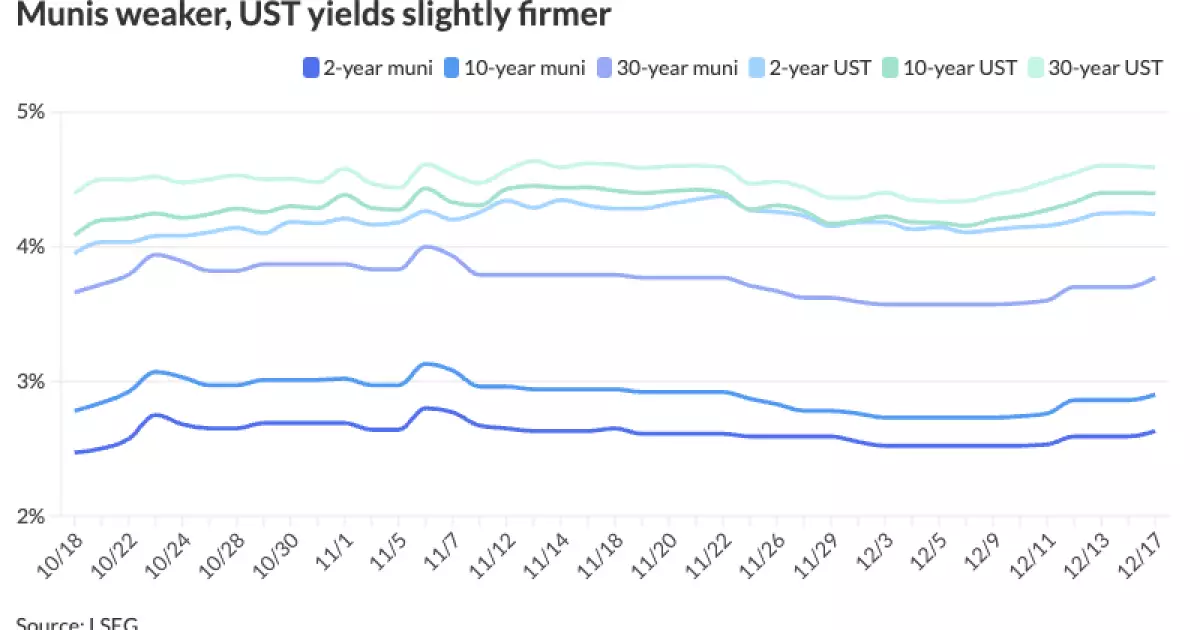As we approach the end of the year, the landscape of the municipal bond market reveals a cascading effect of recent rate speculations and federal monetary policy. On Tuesday, the municipal market experienced notable weakness, primarily driven by the pricing efforts of the New York City Transitional Finance Agency—one of the last big issuers of the year. This scenario unfolds as U.S. Treasuries displayed mixed signals, while equities faced significant losses in anticipation of the Federal Open Market Committee’s (FOMC) rate decision.
The sharp declines across various financial segments signal apprehension among investors, reflecting a continued trend of volatility that began in the preceding week. Analysts widely anticipate a rate cut of 25 basis points from the FOMC during its December meeting. Although this cut seems to be priced into the market, uncertainty lingers concerning subsequent moves by the Federal Reserve. Market participants are particularly eager to decipher any hints from Chairman Jerome Powell’s speech, as the implications of the FOMC’s actions could dictate market direction in the immediate future.
Data shows that yields on triple-A municipal bonds increased by two to seven basis points, hinting at a shift in investor sentiment. Interestingly, the ratios of municipal to U.S. Treasury (UST) yields also saw slight adjustments, reflecting traders’ reactions to ongoing rate cut discussions. Reports from Municipal Market Data reveal that the latest ratios were as follows: 62% for two-year munis, 64% for five-year, 66% for ten-year, and 82% for thirty-year bonds. This data underscores the evolving perceptions of risk and value in the municipal bond sector.
The anticipated quarter-point rate cut is also leading investors to ponder deeper economic insights. Giles Nicholson, a key player in public finance quantitative analysis, expressed that if the prospect of a January cut disappears, it may suggest a more robust economic outlook than previously expected. Rate adjustments moving forward will likely hinge on newly released economic data, making investors acutely aware of upcoming market reports.
The conversation around the federal deficit is equally pressing and paints a daunting picture for U.S. Treasury supply and demand. With an estimated additional need of $22 trillion in UST supply over the next decade as forecasted by the Congressional Budget Office, coupled with potential deficits ranging from $4 trillion to $14 trillion due to tax policy changes, the economic environment may lead to further strain on the financial markets. Matt Fabian from Municipal Market Analytics noted that expectations for federal deficits could further intensify the sell-off observed in UST markets.
Despite the looming headwinds, recent insights indicate that municipal bonds are not solely geared towards closing budget gaps. As municipalities display solid financial health, there’s an expectation that they will tap into the bond market primarily for funding infrastructure projects, such as bridges and toll roads. Projections suggest that issuance could reach as high as $500 billion in 2025, presenting a challenge for investors seeking yields in an increasingly competitive environment.
With a projected busy first quarter of 2024, yields may need to rise to attract investors towards newly issued premium bonds with 4% and 5% coupons. Large upcoming deals in the pipeline, such as San Francisco International Airport’s $1 billion of revenue bonds and additional issuance from the University of California, signal a robust trajectory in municipal financing.
As the market braces itself for the upcoming rate decision, investors must navigate an uncertain terrain filled with implications surrounding federal monetary policy and economic signaling. The demand for well-priced municipal bonds may see significant shifts, particularly if interest rates stabilize or if supply dynamics alter. While some market players could tighten their belts in response to uncertainty, others may find opportunity in the nuances of this evolving landscape.
The intersection of municipal bond performance and federal monetary policy continues to propel discussions about the future of financial markets heading into the new year. Investors are encouraged to stay astute, keeping an eye on both regulatory developments and broader economic indicators that could reshape the dynamics of bond trading in 2024 and beyond. The landscape may be tumultuous, but agility in strategy could lead to promising dividends for those willing to embrace the challenge.


Leave a Reply